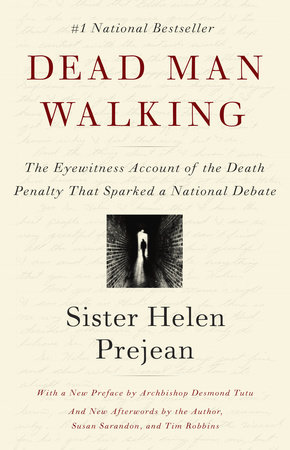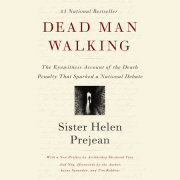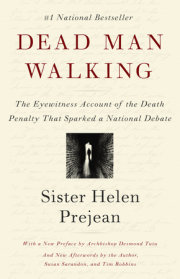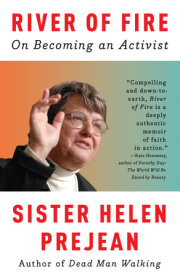CHAPTER
I
When Chava Colon from the Prison Coalition asks me one January day in 1982 to become a pen pal to a death-row inmate, I say, Sure. The invitation seems to fit with my work in St. Thomas, a New Orleans housing project of poor black residents. Not death row exactly, but close. Death is rampant here-from guns, disease, addiction. Medical care scarcely exists.
I've come to St. Thomas to serve the poor, and I assume that someone occupying a cell on Louisiana's death row fits that category. I had learned that back in 1977 at a lecture by John Vodicka, one of the founders of the Louisiana Coalition on Jails and Prisons where Chava now works. I had also learned that the death penalty in the United States has always been most rigorously applied in Southern states-mostly toward those who kill whites. The Prison Coalition office is near Hope House, where I teach high-school dropouts, and Chava and I run into each other fairly often.
After he has written the name of the death-row inmate he says, "Maybe I ought to give you someone else. This guy is a loner and doesn't write. Maybe you want someone who will answer your letters."
But he's already written the name and I say, "Don't change it. Give me his name." I don't know yet that the name on this tiny slip of white paper will be my passport into an eerie land that so far I've only read about in books.
I look at the name and address that Chava gave me: Elmo Patrick Sonnier, number 95281, Death Row, Louisiana State Penitentiary, Angola.
Almost all the killings here in St. Thomas seem to erupt from the explosive mixture of dead-end futures, drugs, and guns. But when Chava describes what Sonnier has done, my blood chills. On November 4, 1977, he and his younger brother, Eddie, abducted from a lovers' lane a teenage couple, David LeBlanc and Loretta Bourque. They raped the girl, forced the young people to lie face down, and shot them in the head.
I look down at the name in horror. Do I really want to know such a man?
"He's a Cajun from St. Martinville, Louisiana," Chava says.
Which makes the murders all the more vicious, because St. Martinville, at the center of Acadiana, is one of the friendliest, most hospitable places on earth. Here and in the surrounding towns French-speaking people, mostly farmers and fishermen, cook good food, swap stories and recipes, and dance the two-step and the zydeco. They love to talk, even to strangers. If murders are prone to happen anywhere on the face of the earth, this is the place one would least expect.
I wonder what I can say to this man. What will he have to say to me?
"We have files at the office," Chava says, "if you want to read about the case."
I take the piece of paper with the name on it back to the apartment in the project where I live with five other nuns.
A year ago, in June of 1981, I had driven a small brown truck loaded with my personal possessions to the apartment on 519 St. Andrew Street and hoped to high heaven I wouldn't be shot. We were practically the only whites-all women-among one thousand five hundred residents in the six square blocks of beige brick buildings tucked between the central business district and the garden district. After my first night in the project apartment, I wrote in my journal:
"Didn't sleep much. Noisy until about 3:00 A.M. People standing on the corner talking and drinking. Feel nervous, unsettled. Heard a gunshot. Had checked when I got into bed to make sure my bed was under the windowsill in case a bullet came through.
"Is this New Orleans? I feel like I'm in another country."
I came to St. Thomas as part of a reform movement in the Catholic Church, seeking to harness religious faith to social justice. In 1971, the worldwide synod of bishops had declared justice a "constitutive" part of the Christian gospel. When you dig way back into Church teachings, you find that this focus on justice has been tucked in there all along in "social encyclicals." Not exactly coffee-table literature. The documents have been called the best-kept secret of the Catholic Church. And with good reason. The mandate to practice social justice is unsettling because taking on the struggles of the poor invariably means challenging the wealthy and those who serve their interests. "Comfort the afflicted and afflict the comfortable"-that's what Dorothy Day, a Catholic social activist said is the heart of the Christian gospel.1
In 1980 my religious community, the Sisters of St. Joseph of Medaille, had made a commitment to "stand on the side of the poor," and I had assented, but reluctantly. I resisted this recasting of the faith of my childhood, where what counted was a personal relationship with God, inner peace, kindness to others, and heaven when this life was done. I didn't want to struggle with politics and economics. We were nuns, after all, not social workers, and some realities in life were, for better or worse, rather fixed-like the gap between rich and poor. Even Jesus Christ himself had said, "The poor you will always have with you." Besides, it was all so complex and confusing-the mess the world was in-with one social problem meshed with other problems. If you tried to get a handle, say, on improving housing for poor people, you found yourself in a morass of bureaucracy and waste in government programs, racist real estate and banking policies, unemployment-a mess.
Enlightenment had come in June 1980. I can remember the moment because it changed my life. My community had assembled at Terre Haute, Indiana, to grapple with directions of our ministries for the 1980s, and the chief speaker was Sister Marie Augusta Neal, S.N.D.deN. A sociologist, she described glaring inequities in the world: two thirds of the peoples of the world live at or below subsistence level while one third live in affluence. Did we know, she asked, that the United States, which comprises about 6 percent of the world's population, consumed 48 percent of the world's goods? What were we to do about such glaring injustices? She knew her facts and I found myself mentally pitting my arguments against her challenge-we were nuns, not social workers, not political. But it's as if she knew what I was thinking. She pointed out that to claim to be apolitical or neutral in the face of such injustices would be, in actuality, to uphold the status quo-a very political position to take, and on the side of the oppressors.
But it was the way she presented the message of Jesus that caused the most radical shift in my perspective.
"The Gospels record that Jesus preached good news to the poor," she said, "and an essential part of that good news was that they were to be poor no longer." Which meant they were not to meekly accept their poverty and suffering as God's will, but, instead, struggle to obtain the necessities of life which were rightfully theirs. And Jesus' challenge to the nonpoor, she emphasized, was to relinquish their affluence and to share their resources with the dispossessed.
Something in me must have been building toward this moment because there was a flash and I realized that my spiritual life had been too ethereal, too disconnected. I left the meeting and began seeking out the poor. This brought me one year later to the St. Thomas housing development.
I had grown up in Baton Rouge, Louisiana, in the 1940s and 1950s in as solid and loving a family as one could hope for-a mother and father who lavished attention and affection on their children and a brother, Louie, and sister, Mary Ann, whom I could spar with and tease and argue with and love. We grew up in a spacious two-story house, were educated in Catholic schools, and traveled extensively across the United States, Canada, and Europe.
As a child, at Mama's urging, I knelt by my bed at night for prayers and always included "poor people who have no place to sleep tonight." But poor people occupied a land somewhere out there with Cinderella and Hansel and Gretel. I did not have any direct experience with poor people.
I did not then consider the "colored" people who worked for us as poor. They were just, well, "colored" people doing what "colored" people did, which was working for white people, and living where "colored" people lived, which was usually in shacks out in the country or, in "nigger town" in the city. In my early childhood a black couple lived in the "servants' quarters," a small house behind ours. The man took care of the yard, the woman in a white uniform helped in the house. They never used the family bathrooms and they always ate in the kitchen. Only whites went to the elementary and high school I attended, and in our church blacks could sit only in a niche of pews over to the side and had to wait until last to receive communion. They had to sit at the back of the bus, and it was a great dare for a white kid to go to the back of the bus and sit with the blacks for five seconds. I had taken on the dare more than once, then rushed back to the front of the bus to amused, giggling friends.
Yet, even when I was a child there was something in black people that drew me to them. Once, when I was five years old, I remember making my way over to the group of black men Daddy had hired to remove a stump from our front yard, and I watched and listened as they swung axes in fluid motion and moaned bluesy songs and swapped stories about women and drinking and going to jail. This was life so raw, so earthy, so uncushioned, yet so vibrant, so tenacious, so enduring. I was fascinated. Mama was not. She spotted me and told me to get inside.
I was twelve years old the first time I witnessed physical violence against a black person. Elise Gauthier, my friend and classmate, and I rode the bus one December day in 1952 to Third Street to do our Christmas shopping. We were in seventh grade; everything was funny that year, and we had a great time on the bus, teasing and laughing uproariously over twelve-year-olds' jokes. The bus stopped at the end of Third Street and everyone on the bus was getting out when Elise and I heard the bus driver shout an obscenity to a young black woman and saw him kick her with his foot off the bus and onto the sidewalk. She landed on her hands and knees and her purse flew open and coins rolled all over. She didn't say a word, did not even look at the bus driver, just picked herself up and walked away.
I felt awful. My parents never acted mean to black people, even though they never questioned the system of racial discrimination that permeated every aspect of life. Daddy, an attorney, represented a slew of black clients, charging them five dollars for his services, and he helped several families buy property and, eventually, own their own homes. It would take me a long time to understand how systems inflict pain and hardship in people's lives and to learn that being kind in an unjust system is not enough.
Now, here in St. Thomas, I am learning plenty about systems and what happens to the people in them, here in a state whose misery statistics are the highest in the nation-where residents bring home an average yearly income of $10,890, where half the adult population has not completed high school, where one in every six persons is a food-stamp recipient, one of every three babies born has an unwed mother, and the violent crime rate is ninth highest in the nation.2
I am meeting seventeen-year-old girls who have had one, sometimes two children. Without a chance for college, a senior trip to Florida, the possibility of a career, and the independence and mobility that a car gives, they are vulnerable to the first young man who looks at them. Sixteen-year-old Lily, swaying with the blanketed bundle in her arms as if she were holding a doll, tells me the familiar story that she wanted a baby so she could have "something of my very own."
With paper and pencil I am helping Shirley, a single mother, compute how to make ends meet for herself and her child on an AFDC (Aid to Families with Dependent Children) check of $138 a month and $123 in food stamps. I witness her agony of deciding if she should give up AFDC and get a job, which means losing medicaid, the only health insurance she has for her child. The cashier's job at a supermarket which she is considering pays minimum wages and is part-time-thirty-five hours a week (the policy of most supermarkets in the city), which means that she won't get medical or retirement benefits. The St. Thomas residents who do find full-time work usually receive minimum wages, which amounts to about thirty-five dollars a month above the AFDC income level. (1990 Census Bureau statistics reveal that full-time minimum-wage earners received $8,840 a year.) Plus, mothers like Shirley, who choose work instead of welfare, face additional costs of child care, medical bills, an increase in rent (proportionate to income), and transportation expenses. I had always thought that jobs were the way out of poverty. Now I'm learning the meaning of working poor. (In 1989 37.3 million working Americans, accounting for 39 percent of total tax returns, received incomes below $15,000.)3
At the supper table at night I am listening to the stories Sister Therese St. Pierre tells of the three- and four-year-olds in her preschool group who do not know words like "over" or "lettuce" or "sofa." Most of these children will hit the overpopulated, understaffed, ill-equipped public schools with "failure by third grade" stamped on their foreheads.
I am watching how easy it is for a teenage boy to "run a bag" of cocaine down the street for an easy twenty bucks. (If he gets an after-school or summer job, his income will be deducted from his mother's AFDC check.)
I am seeing, with my own eyes-shocked, disbelieving-bags of white powder peddled in the open with no police in sight. Sister Lory Schaff, who began Hope House in 1969, tells of meeting in 1972 with a high-ranking city official to express her concern about the freewheeling dope peddling in St. Thomas, and of being met with, "Well, now, Sister, we know drugs are going to pop up somewhere in every city. At least we know where they are."
I also notice that when residents of St. Thomas are killed, the newspaper barely takes notice, whereas when white citizens are killed, there is often a front-page story.
Copyright © 1994 by Sister Helen Prejean. All rights reserved. No part of this excerpt may be reproduced or reprinted without permission in writing from the publisher.











